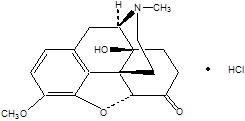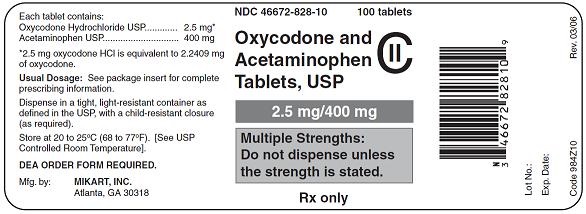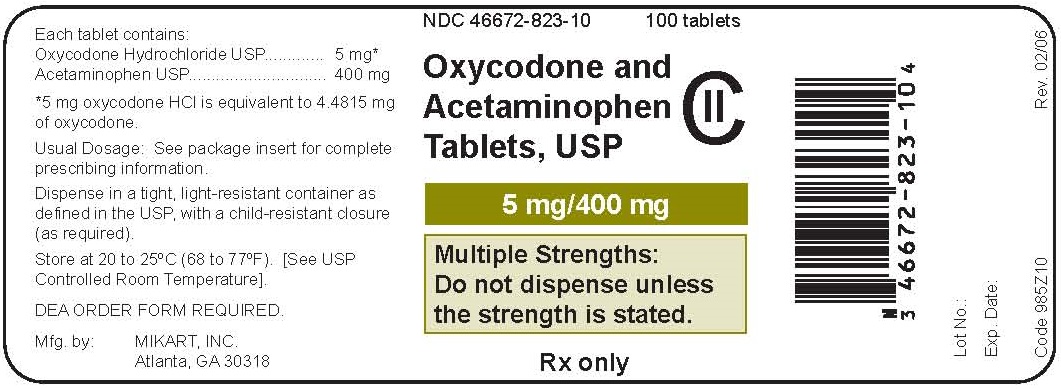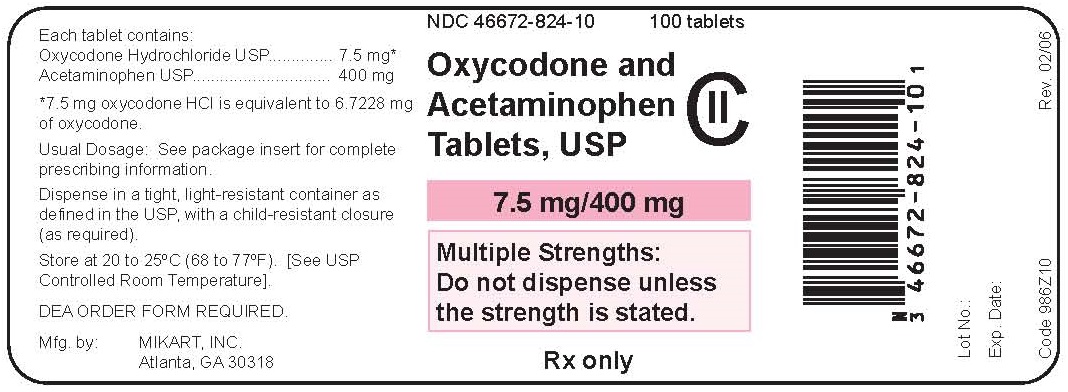OXYCODONE AND ACETAMINOPHEN- oxycodone and acetaminophen tablet
MIKART, INC.
----------
OXYCODONE AND ACETAMINOPHEN TABLETS, USP CII
DESCRIPTION
Each tablet, for oral administration, contains oxycodone hydrochloride and acetaminophen in the following strengths:
Oxycodone Hydrochloride USP 2.5 mg*
Acetaminophen USP 400 mg
*2.5 mg oxycodone HCl is equivalent to 2.2409 mg of oxycodone.
Oxycodone Hydrochloride USP 5 mg*
Acetaminophen USP 400 mg
*5 mg oxycodone HCl is equivalent to 4.4815 mg of oxycodone.
Oxycodone Hydrochloride USP 7.5 mg*
Acetaminophen USP 400 mg
*7.5 mg oxycodone HCl is equivalent to 6.7228 mg of oxycodone.
Oxycodone Hydrochloride USP 10 mg*
Acetaminophen USP 400 mg
*10 mg oxycodone HCl is equivalent to 8.9637 mg of oxycodone.
Oxycodone and Acetaminophen Tablets, USP also contain the following inactive ingredients: croscarmellose sodium, crospovidone, microcrystalline cellulose, povidone, pregelatinized starch, silicon dioxide, and stearic acid.
Acetaminophen, 4’-hydroxyacetanilide, is a non-opiate, non-salicylate analgesic and antipyretic which occurs as a white, odorless, crystalline powder, possessing a slightly bitter taste. The molecular formula for acetaminophen is C 8H 9NO 2 and the molecular weight is 151.16. It may be represented by the following structural formula:

Oxycodone, 14-hydroxydihydrocodeinone, is a semisynthetic pure opioid agonist which occurs as a white, odorless, crystalline powder having a saline, bitter taste. The molecular formula for oxycodone hydrochloride is C 18H 21NO 4•HCl and the molecular weight is 351.82. It is derived from the opium alkaloid thebaine, and may be represented by the following structural formula:

CLINICAL PHARMACOLOGY
The principal ingredient, oxycodone, is a semisynthetic opioid analgesic with multiple actions qualitatively similar to those of morphine; the most prominent involves the central nervous system and organs composed of smooth muscle. The principle actions of therapeutic value of the oxycodone in Oxycodone and Acetaminophen Tablets, USP are analgesia and sedation.
Oxycodone is similar to codeine and methadone in that it retains at least one-half of its analgesic activity when administered orally.
Acetaminophen is a non-opiate, non-salicylate analgesic and antipyretic.
INDICATIONS AND USAGE
Oxycodone and Acetaminophen Tablets, USP is indicated for the relief of moderate to moderately severe pain.
CONTRAINDICATIONS
Oxycodone and Acetaminophen Tablets, USP should not be administered to patients who are hypersensitive to oxycodone, acetaminophen, or any other components of this product.
WARNINGS
Drug Dependence
Oxycodone can produce drug dependence of the morphine type and, therefore, has the potential for being abused. Psychic dependence, physical dependence and tolerance may develop upon repeated administration of Oxycodone and Acetaminophen Tablets, USP and it should be prescribed and administered with the same degree of caution appropriate to the use of other oral opioid-containing medications. Like other opioid-containing medications, Oxycodone and Acetaminophen Tablets, USP is subject to the Federal Controlled Substances Act (Schedule II).
PRECAUTIONS
General
Head Injury and Increased Intracranial Pressure: The respiratory depressant effects of opioids and their capacity to elevate cerebrospinal fluid pressure may be markedly exaggerated in the presence of head injury, other intracranial lesions or a pre-existing increase in intracranial pressure. Furthermore, opioids produce adverse reactions which may obscure the clinical course of patients with head injuries.
Acute Abdominal Conditions: The administration of Oxycodone and Acetaminophen Tablets, USP or other opioids may obscure the diagnosis or clinical course in patients with acute abdominal conditions.
Special Risk Patients: Oxycodone and acetaminophen tablets should be given with caution to certain patients such as the elderly or debilitated, and those with severe impairment of hepatic or renal function, hypothyroidism, Addison’s disease, and prostatic hypertrophy or urethral stricture.
Information for Patients
Oxycodone may impair the mental and/or physical abilities required for the performance of potentially hazardous tasks such as driving a car or operating machinery. The patient using oxycodone and acetaminophen tablets should be cautioned accordingly.
Drug Interactions
Patient receiving other opioid analgesics, general anesthetics, phenothiazines, other tranquilizers, sedative-hypnotics or other CNS depressants (including alcohol) concomitantly with Oxycodone and Acetaminophen Tablets, USP may exhibit an additive CNS depression. When such combined therapy is contemplated, the dose of one or both agents should be reduced.
The concurrent use of anticholinergics with opioids may produce paralytic ileus.
Usage in Pregnancy
Teratogenic Effects; Pregnancy Category C:
Animal reproductive studies have not been conducted with Oxycodone and Acetaminophen Tablets, USP. It is also not known whether oxycodone and acetaminophen tablets can cause fetal harm when administered to a pregnant woman or can affect reproductive capacity. Oxycodone and acetaminophen tablets should not be given to a pregnant woman unless in the judgment of the physician, the potential benefits outweigh the possible hazards.
ADVERSE REACTIONS
The most frequently observed adverse reactions include lightheadedness, dizziness, sedation, nausea and vomiting. These effects seem to be more prominent in ambulatory than in nonambulatory patients, and some of these adverse reactions may be alleviated if the patient lies down.
Other adverse reactions include euphoria, dysphoria, constipation, skin rash and pruritus. At higher doses, oxycodone has most of the disadvantages of morphine including respiratory depression.
DRUG ABUSE AND DEPENDENCE
Oxycodone and Acetaminophen Tablets, USP is a Schedule II controlled substance.
Oxycodone can produce drug dependence and has the potential for being abused (See WARNINGS).
OVERDOSAGE
Acetaminophen
Signs and Symptoms: In acute acetaminophen overdosage, dose-dependent, potentially fatal hepatic necrosis is the most serious adverse effect. Renal tubular necrosis, hypoglycemic coma and thrombocytopenia may also occur.
In adults, hepatic toxicity has rarely been reported with acute overdoses of less than 10 grams and fatalities with less than 15 grams. Importantly, young children seem to be more resistant than adults to the hepatotoxic effect of an acetaminophen overdose. Despite this, the measures outlined below should be initiated in any adult or child suspected of having ingested an acetaminophen overdose.
Early symptoms following a potentially hepatotoxic overdose may include: nausea, vomiting, diaphoresis and general malaise. Clinical and laboratory evidence of hepatic toxicity may not be apparent until 48 to 72 hours post-ingestion.
Treatment: The stomach should be emptied promptly by lavage or by induction of emesis with syrup of ipecac. Patient’s estimates of the quantity of a drug ingested are notoriously unreliable. Therefore, if an acetaminophen overdose is suspected, a serum acetaminophen assay should be obtained as early as possible, but no sooner than four hours following ingestion. Liver function studies should be obtained initially and repeated at 24-hour intervals.
The antidote, N-acetylcysteine, should be administered as early as possible, preferably within 16 hours of the overdose ingestion for optimal results, but in any case, within 24 hours. Following recovery, there are no residual, structural, or functional hepatic abnormalities.
Oxycodone
Signs and Symptoms: Serious overdosage with oxycodone is characterized by respiratory depression (a decrease in respiratory rate and/or tidal volume, Cheyne-Stokes respiration, cyanosis), extreme somnolence progressing to stupor or coma, skeletal muscle flaccidity, cold and clammy skin, and sometimes bradycardia and hypotension. In severe overdosage, apnea, circulatory collapse, cardiac arrest and death may occur.
Treatment: Primary attention should be given to the reestablishment of adequate respiratory exchange through provision of a patent airway and the institution of assisted or controlled ventilation. The opioid antagonist naloxone hydrochloride is a specific antidote against respiratory depression which may result from overdosage or unusual sensitivity to opioids, including oxycodone. Therefore, an appropriate dose of naloxone hydrochloride (usual initial adult dose 0.4 mg to 2 mg) should be administered preferably by the intravenous route, and simultaneously with efforts at respiratory resuscitation (see package insert). Since the duration of action of oxycodone may exceed that of the antagonist, the patient should be kept under continued surveillance and repeated doses of the antagonist should be administered as needed to maintain adequate respiration.
An antagonist should not be administered in the absence of clinically significant respiratory or cardiovascular depression. Oxygen, intravenous fluids, vasopressors and other supportive measures should be employed as indicated.
Gastric emptying may be useful in removing unabsorbed drug.
DOSAGE AND ADMINISTRATION
Dosage should be adjusted according to the severity of the pain and the response of the patient. It may occasionally be necessary to exceed the usual dosage recommended below in cases of more severe pain or in those patients who have become tolerant to the analgesic effect of opioids. Oxycodone and Acetaminophen Tablets, USP is given orally.
Oxycodone and Acetaminophen Tablets USP 2.5 mg/400 mg
The usual adult dosage is one or two tablets every six hours (maximal daily dose of Oxycodone and Acetaminophen Tablets USP 2.5 mg/400 mg is 10 tablets). The total daily dose of acetaminophen should not exceed 4 grams.
Oxycodone and Acetaminophen Tablets USP 5 mg/400 mg
The usual adult dosage is one tablet every six hours as needed for pain. The total daily dose of acetaminophen should not exceed 4 grams. (maximal daily dose of Oxycodone and Acetaminophen Tablets USP 5 mg/400 mg is 10 tablets).
Oxycodone and Acetaminophen Tablets USP 7.5 mg/400 mg
The usual adult dosage is one tablet every six hours as needed for pain. The total daily dose of acetaminophen should not exceed 4 grams. (maximal daily dose of Oxycodone and Acetaminophen Tablets USP 7.5 mg/400 mg is 8 tablets).
Oxycodone and Acetaminophen Tablets USP 10 mg/400 mg
The usual adult dosage is one tablet every six hours as needed for pain. The total daily dose of acetaminophen should not exceed 4 grams. (maximal daily dose of Oxycodone and Acetaminophen Tablets USP 10 mg/400 mg is 6 tablets).
HOW SUPPLIED
Oxycodone and Acetaminophen Tablets, USP are supplied as follows:
2.5 mg/400 mg
White capsule shaped tablets, debossed “2.5/400” on one side and “ADG” on the other side in bottles of 100, NDC 46672-828-10 and bottles of 500, NDC 46672-828-50.
5 mg/400 mg
White capsule shaped tablets, debossed “5/400” on one side and “ADG” on the other side in bottles of 100, NDC 46672-823-10 and bottles of 500, NDC 46672-823-50.
7.5 mg/400 mg
White capsule shaped tablets, debossed “7.5/400” on one side and “ADG” on the other side in bottles of 100, NDC 46672-824-10 and bottles of 500, NDC 46672-824-50.
10 mg/400 mg
White capsule shaped tablets, debossed “10/400” on one side and “ADG” on the other side in bottles of 100, NDC 46672-825-10 and bottles of 500, NDC 46672-825-50.
| OXYCODONE AND ACETAMINOPHEN
oxycodone and acetaminophen tablet |
||||||||||||||||||||
|
||||||||||||||||||||
|
||||||||||||||||||||
|
||||||||||||||||||||
|
||||||||||||||||||||
|
||||||||||||||||||||
|
||||||||||||||||||||
| OXYCODONE AND ACETAMINOPHEN
oxycodone and acetaminophen tablet |
||||||||||||||||||||
|
||||||||||||||||||||
|
||||||||||||||||||||
|
||||||||||||||||||||
|
||||||||||||||||||||
|
||||||||||||||||||||
|
||||||||||||||||||||
| OXYCODONE AND ACETAMINOPHEN
oxycodone and acetaminophen tablet |
||||||||||||||||||||
|
||||||||||||||||||||
|
||||||||||||||||||||
|
||||||||||||||||||||
|
||||||||||||||||||||
|
||||||||||||||||||||
|
||||||||||||||||||||
| OXYCODONE AND ACETAMINOPHEN
oxycodone and acetaminophen tablet |
||||||||||||||||||||
|
||||||||||||||||||||
|
||||||||||||||||||||
|
||||||||||||||||||||
|
||||||||||||||||||||
|
||||||||||||||||||||
|
||||||||||||||||||||
| Labeler - MIKART, INC. (030034847) |
| Registrant - Mikart, Inc. (030034847) |



